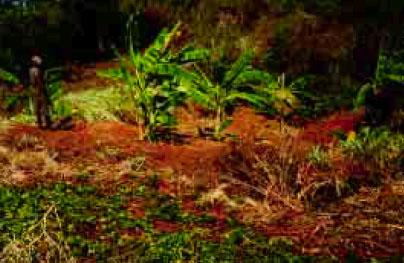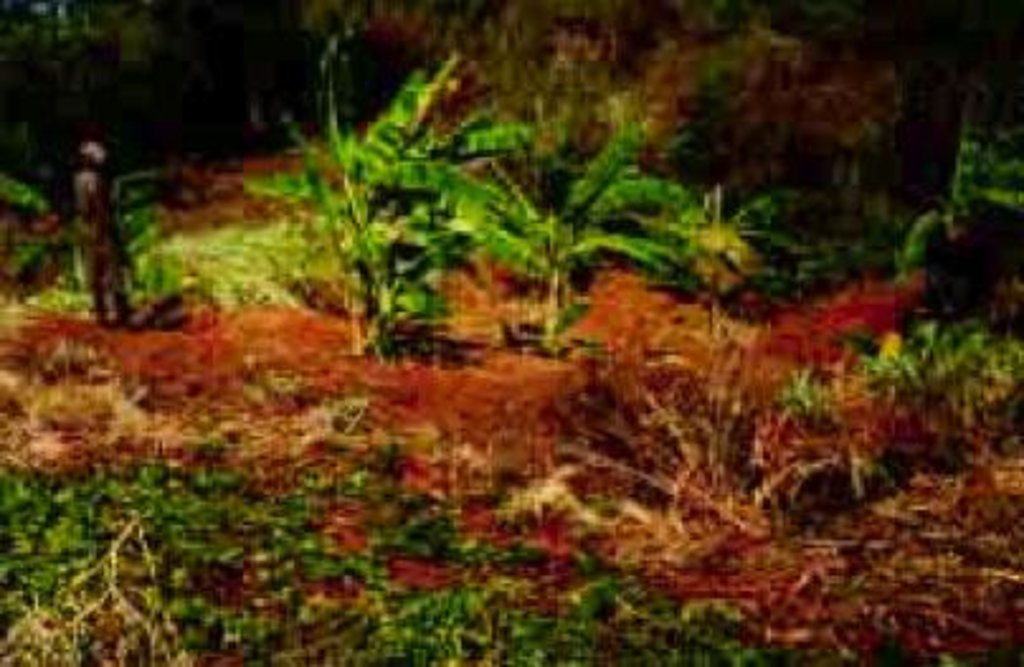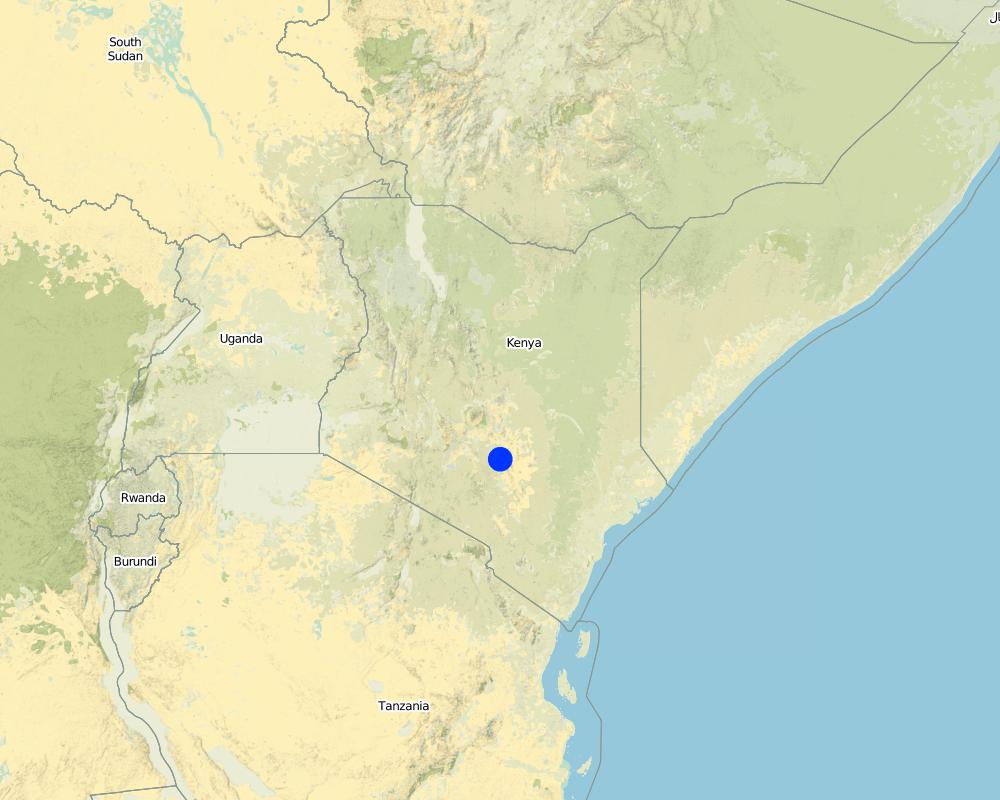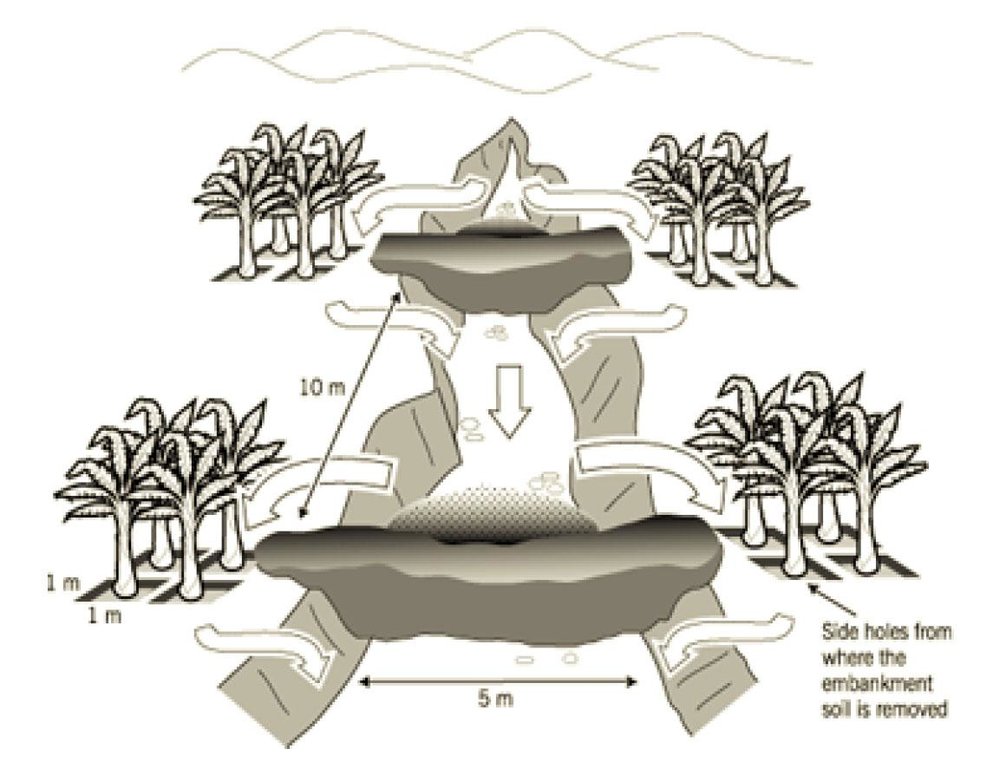Gully Rehabilitation [Kenya]
- Création :
- Mise à jour :
- Compilateur : Kithinji Mutunga
- Rédacteur : –
- Examinateurs : David Streiff, Alexandra Gavilano
technologies_1488 - Kenya
Voir les sections
Développer tout Réduire tout1. Informations générales
1.2 Coordonnées des personnes-ressources et des institutions impliquées dans l'évaluation et la documentation de la Technologie
Spécialiste GDT:
Kiio Jacqueline
MOARD
Kenya
exploitant des terres:
Kirimi Patrick
MOARD
Kenya
Spécialiste GDT:
Gitau Mary
MOARD
Kenya
Nom du ou des institutions qui ont facilité la documentation/ l'évaluation de la Technologie (si pertinent)
Food and Agriculture Organization of the United Nations (FAO) - Italie1.3 Conditions relatives à l'utilisation par WOCAT des données documentées
Le compilateur et la(les) personne(s) ressource(s) acceptent les conditions relatives à l'utilisation par WOCAT des données documentées:
Oui
2. Description de la Technologie de GDT
2.1 Courte description de la Technologie
Définition de la Technologie:
Erosion control by use of physical barriers and vegetative materials
2.2 Description détaillée de la Technologie
Description:
The innovation comprises control of gully erosion by use of constructed barriers (check dams) combined with vegetative materials. The end result is a stabilized gully that is prevented from advancing further. The system also involves fruit trees/banana establishment and fodder grass planting for structure stabilization. Establishment of the technology involves excavation of pits, planting fruit trees/bananas and grass cuttings.
Purpose of the Technology: This is a structural measure that is vegetated for stabilization. Its purpose is to rehabilitate a gully bed, through control of concentrated runoff by reduction of slope length and both trapping of runoff and sediment harvesting. The productive use of the innovation is mainly for perennial crops (fruit trees and
bananas) and for fodder production.
Establishment / maintenance activities and inputs: Earth check dams are constructed in the gully, using borrow spoil from square pits in the walls of the gully (see diagram). The earth embankment of the dams are then stabilized with grass. Pawpaws are planted on the original gully floor. Initially the innovator left the pits empty: now she plants bananas in them.The 5 check dams, each 1 m or more in height, are spaced at about 10 m apart in the gully. The excavated pits are about 1 m x 1 m wide and 1 m deep. Four pits are dug separately on each side of each check dam. Makarikari grass (Panicum coloratum var. makarikariensis) is used for stabilization, while bananas and pawpaws are planted within the rehabilitated area. When it rains, runoff generated from the neighbouring plots upstream flows down and is slowed by the check dams. The runoff passes around both wings of each embankment, filling and flowing through the pits. Sediment is trapped in the pits. Excess runoff flows on to the second embankment, then through the second set of pits and so on. Only during heavy rains does water pass through and out of the system, though its velocity is reduced. Thus the gully heals slowly with time and vegetation becomes established. Regular maintenance work is required, involving repair of broken sections from time to time, using manual labour with a panga, shovel and jembe. Also of importance is manure application every season to the planted areas before the rains to sustain fertility and thus productivity.
Natural / human environment: Kalekye Mutua is a single household head in her mid thirties. Although she has no partner to help support her three children, she manages quite well through farming her 6 hectares of land - where she grows various crops and keeps a few local cattle. She had a small trading venture but has recently abandoned
this. Kalekye is not amongst the poorest in Mwingi, but represents a number of female-headed households who prosper through hard work and enterprise. In fact she even employs labourers part-time to help with the farming activities.
2.3 Photos de la Technologie
2.5 Pays/ région/ lieux où la Technologie a été appliquée et qui sont couverts par cette évaluation
Pays:
Kenya
Région/ Etat/ Province:
Eastern Province
Spécifiez la diffusion de la Technologie:
- répartie uniformément sur une zone
S'il n'existe pas d'informations exactes sur la superficie, indiquez les limites approximatives de la zone couverte:
- < 0,1 km2 (10 ha)
Commentaires:
a very small portion of the individual farm is covered by the technology
Map
×2.6 Date de mise en œuvre de la Technologie
Si l'année précise est inconnue, indiquez la date approximative: :
- il y a plus de 50 ans (technologie traditionnelle)
2.7 Introduction de la Technologie
Spécifiez comment la Technologie a été introduite: :
- dans le cadre d'un système traditionnel (> 50 ans)
Commentaires (type de projet, etc.) :
farmers own intiative
3. Classification de la Technologie de GDT
3.1 Principal(aux) objectif(s) de la Technologie
- réduire, prévenir, restaurer les terres dégradées
3.2 Type(s) actuel(s) d'utilisation des terres, là où la Technologie est appliquée

Terres cultivées
- Cultures pérennes (non ligneuses)
- Plantations d’arbres ou de buissons
Cultures pérennes (non ligneuses) - Précisez les cultures:
- bananier/plantain/abaca
Plantations d'arbres et d'arbustes - Précisez les cultures:
- fruits à pépins (pommes, poires, coings, etc.)
Nombre de période de croissance par an: :
- 2
Précisez:
Longest growing period in days: 60 Longest growing period from month to month: Oct - Dec Second longest growing period in days: 75 Second longest growing period from month to month: Mar - May
Commentaires:
Fruit trees / shrubs species: pawpaws (Asimina triloba)
Perennial crops species: bananas
Major land use problems (compiler’s opinion): soil erosion, overgrazing, declining soil fertility
Major land use problems (land users’ perception): low yields
3.4 Approvisionnement en eau
Approvisionnement en eau des terres sur lesquelles est appliquée la Technologie:
- pluvial
3.5 Groupe de GDT auquel appartient la Technologie
- Amélioration de la couverture végétale/ du sol
- récupération/ collecte de l'eau
- dérivation et drainage de l'eau
3.6 Mesures de GDT constituant la Technologie

pratiques végétales

structures physiques
- S3: Fossés étagés, canaux, voies d'eau
Commentaires:
Main measures: vegetative measures
Secondary measures: structural measures
3.7 Principaux types de dégradation des terres traités par la Technologie

érosion hydrique des sols
- Wg: ravinement/ érosion en ravines
3.8 Prévention, réduction de la dégradation ou réhabilitation des terres dégradées
Spécifiez l'objectif de la Technologie au regard de la dégradation des terres:
- réduire la dégradation des terres
4. Spécifications techniques, activités, intrants et coûts de mise en œuvre
4.1 Dessin technique de la Technologie
Spécifications techniques (associées au dessin technique):
Gully under reclamation: note flow of runoff
Kenya
Technical knowledge required for field staff / advisors: low
Technical knowledge required for land users: moderate
Main technical functions: control of concentrated runoff: retain / trap, control of concentrated runoff: impede / retard
Secondary technical functions: reduction of slope angle, improvement of ground cover, increase of infiltration, water harvesting / increase water supply, sediment retention / trapping, sediment harvesting
Fruit trees / shrubs species: pawpaws
Perennial crops species: bananas
Slope (which determines the spacing indicated above): 10.00%
If the original slope has changed as a result of the Technology, the slope today is (see figure below): 5.00%
Construction material (earth): Local soil excavated from pits on the side of the gully
Construction material (other): Grass for stabilization Makarikari grass prefeered
Slope (which determines the spacing indicated above): 10%
If the original slope has changed as a result of the Technology, the slope today is: 8%
Vegetation is used for stabilisation of structures.
4.2 Informations générales sur le calcul des intrants et des coûts
autre/ monnaie nationale (précisez):
kenya shillings
Indiquez le taux de change des USD en devise locale, le cas échéant (p.ex. 1 USD = 79.9 réal brésilien): 1 USD = :
70,0
Indiquez le coût salarial moyen de la main d'œuvre par jour:
2.14
4.3 Activités de mise en place/ d'établissement
| Activité | Calendrier des activités (saisonnier) | |
|---|---|---|
| 1. | digging banana holes | dry season |
| 2. | acquisition of grass cuttings | dry season |
| 3. | acquisition of banana cuttings | before |
| 4. | planting of grass and bananas | onset of rain |
| 5. | manure application | before the rains |
| 6. | Excavation | Dry season |
4.4 Coûts et intrants nécessaires à la mise en place
Commentaires:
Duration of establishment phase: 24 month(s)
4.5 Activités d'entretien/ récurrentes
| Activité | Calendrier/ fréquence | |
|---|---|---|
| 1. | repair of broken structures | after rains /seasonally |
| 2. | weeding | during rains /twice /season |
| 3. | banana prunning | after rains /biannually |
| 4. | manure application | dry season /annually |
| 5. | Repair of broken sections | during /after rains/seasonally |
| 6. | Stabilization with grass | during rains/when required |
4.6 Coûts et intrants nécessaires aux activités d'entretien/ récurrentes (par an)
Commentaires:
1100 banana/ fruit trees holes/ha
4.7 Facteurs les plus importants affectant les coûts
Décrivez les facteurs les plus importants affectant les coûts :
slope, soil type, timeliness of operation
5. Environnement naturel et humain
5.1 Climat
Précipitations annuelles
- < 250 mm
- 251-500 mm
- 501-750 mm
- 751-1000 mm
- 1001-1500 mm
- 1501-2000 mm
- 2001-3000 mm
- 3001-4000 mm
- > 4000 mm
Zone agro-climatique
- semi-aride
5.2 Topographie
Pentes moyennes:
- plat (0-2 %)
- faible (3-5%)
- modéré (6-10%)
- onduleux (11-15%)
- vallonné (16-30%)
- raide (31-60%)
- très raide (>60%)
Reliefs:
- plateaux/ plaines
- crêtes
- flancs/ pentes de montagne
- flancs/ pentes de colline
- piémonts/ glacis (bas de pente)
- fonds de vallée/bas-fonds
Zones altitudinales:
- 0-100 m
- 101-500 m
- 501-1000 m
- 1001-1500 m
- 1501-2000 m
- 2001-2500 m
- 2501-3000 m
- 3001-4000 m
- > 4000 m
5.3 Sols
Profondeur moyenne du sol:
- très superficiel (0-20 cm)
- superficiel (21-50 cm)
- modérément profond (51-80 cm)
- profond (81-120 cm)
- très profond (>120 cm)
Texture du sol (de la couche arable):
- grossier/ léger (sablonneux)
Matière organique de la couche arable:
- faible (<1%)
Si disponible, joignez une description complète du sol ou précisez les informations disponibles, par ex., type de sol, pH/ acidité du sol, capacité d'échange cationique, azote, salinité, etc.
Soil fertility is low
Soil drainage / infiltration is good
Soil water storage capacity is low
5.6 Caractéristiques des exploitants des terres appliquant la Technologie
Revenus hors exploitation:
- moins de 10% de tous les revenus
Niveau de mécanisation:
- travail manuel
Indiquez toute autre caractéristique pertinente des exploitants des terres:
Population density: < 10 persons/km2
Annual population growth: 2% - 3%
1% of the land users are very rich and own 10% of the land.
4% of the land users are rich and own 20% of the land.
25% of the land users are average wealthy and own 40% of the land.
30% of the land users are poor and own 20% of the land.
40% of the land users are poor and own 10% of the land.
Off-farm income specification: the are few members of the household who are in formal employment
5.8 Propriété foncière, droits d’utilisation des terres et de l'eau
Propriété foncière:
- individu, sans titre de propriété
Droits d’utilisation des terres:
- individuel
6. Impacts et conclusions
6.1 Impacts sur site que la Technologie a montrés
Impacts socio-économiques
Production
production fourragère
surface de production
Revenus et coûts
revenus agricoles
Commentaires/ spécifiez:
Sale of bananas
Impacts écologiques
Cycle de l'eau/ ruissellement
ruissellement de surface
Quantité avant la GDT:
60
Quantité après la GDT:
10
Sols
humidité du sol
couverture du sol
perte en sol
Quantité avant la GDT:
610
Quantité après la GDT:
1
6.4 Analyse coûts-bénéfices
Quels sont les bénéfices comparativement aux coûts de mise en place (du point de vue des exploitants des terres)?
Rentabilité à court terme:
légèrement positive
Rentabilité à long terme:
très positive
Quels sont les bénéfices comparativement aux coûts d'entretien récurrents (du point de vue des exploitants des terres)?
Rentabilité à court terme:
positive
Rentabilité à long terme:
positive
6.5 Adoption de la Technologie
- cas isolés/ expérimentaux
Si disponible, quantifiez (nombre de ménages et/ou superficie couverte):
1 household
De tous ceux qui ont adopté la Technologie, combien d'entre eux l'ont fait spontanément, à savoir sans recevoir aucune incitation matérielle, ou aucune rémunération? :
- 91-100%
Commentaires:
100% of land user families have adopted the Technology without any external material support
There is no trend towards spontaneous adoption of the Technology
Comments on adoption trend: Kalekye only started the innovation two years ago, and while there has been a policy of taking women’s groups to visit Kalekye, this is a relatively recent occurrence (starting approximately a year ago). Despite the visitors obviously being inspired, there have been no reports as yet of direct adoption of the technology.
6.7 Points forts/ avantages/ possibilités de la Technologie
| Points forts/ avantages/ possibilités du point de vue du compilateur ou d'une autre personne ressource clé |
|---|
|
Reclamation of land for production of fodder and bananas How can they be sustained / enhanced? Possible improvements would include planting improved fruit trees that are rapidly maturing and yield more: grafted mangoes for example |
6.8 Faiblesses/ inconvénients/ risques de la Technologie et moyens de les surmonter
| Faiblesses/ inconvénients/ risques du point de vue du compilateur ou d'une autre personne ressource clé | Comment peuvent-ils être surmontés? |
|---|---|
| High labour requirements |
7. Références et liens
7.1 Méthodes/ sources d'information
7.2 Références des publications disponibles
Titre, auteur, année, ISBN:
Farm Management handbook of Kenya Vol II
Disponible à partir d'où? Coût?
Ministry of Agiculture, Nairobi
Titre, auteur, année, ISBN:
Kithinji M., Critchley W. 2001. Farmers' initiatives in land husbandry: Promising technologies for the drier areas of East Africa. RELMA Technical Report series no. 27
Liens et modules
Développer tout Réduire toutLiens
Aucun lien
Modules
Aucun module trouvé





